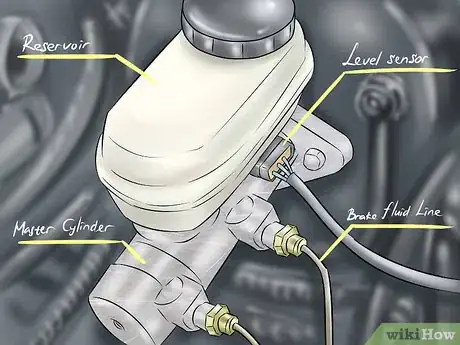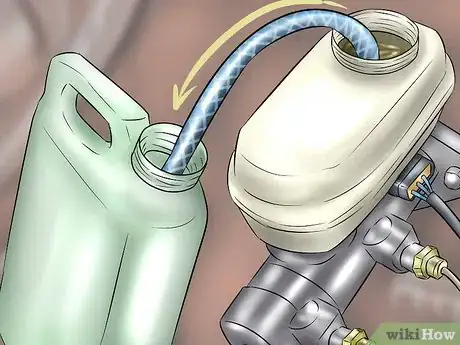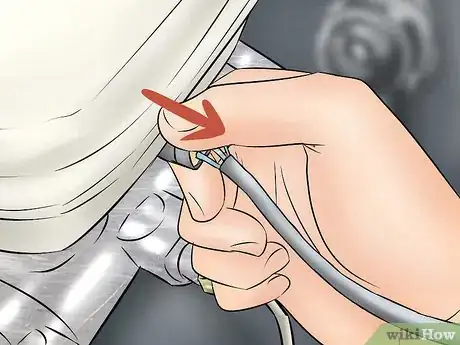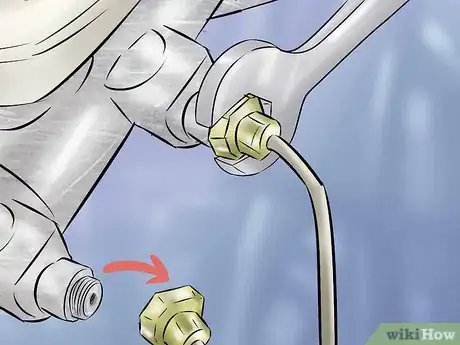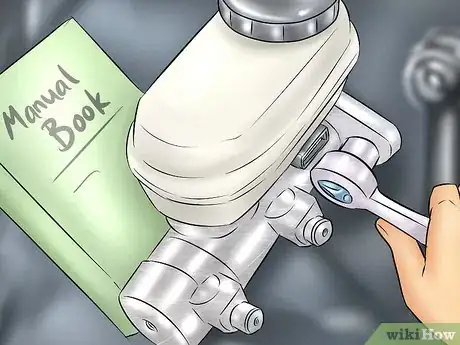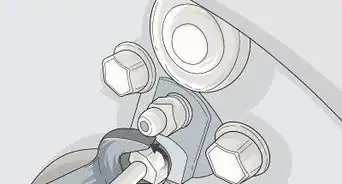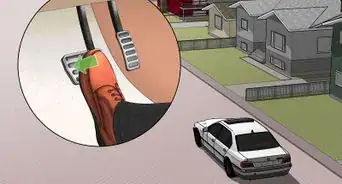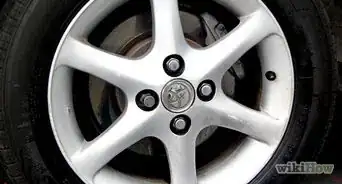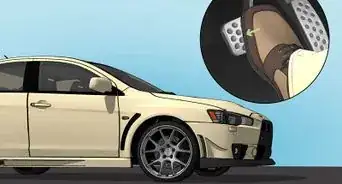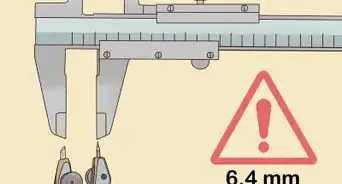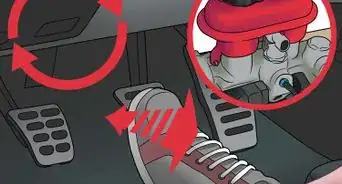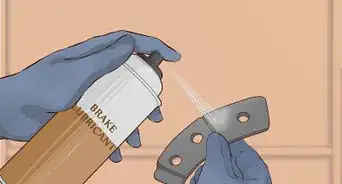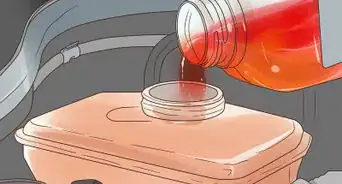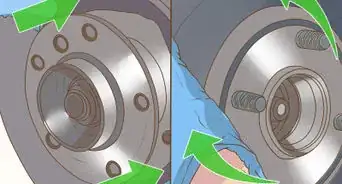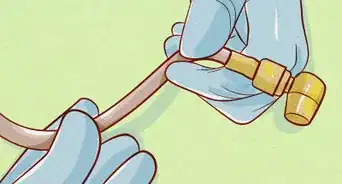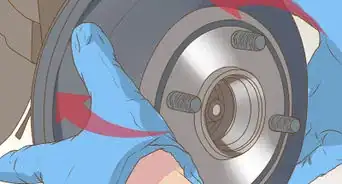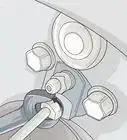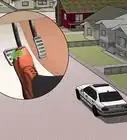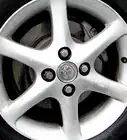X
This article was co-authored by Matthew Rava and by wikiHow staff writer, Sophia Latorre. Matthew Rava is an Auto Repair Expert and the Co-founder & Head of Marketing of Brakes to You. He specializes in auto repairs that concern brakes. Matthew earned a BS from West Chester University of Pennsylvania.
This article has been viewed 296,780 times.
The brake master cylinder is a key component of a vehicle's brake system. If this component fails, then your vehicle's braking ability will be weakened or destroyed. To avoid this safety hazard, it is best to replace the brake master cylinder. The following is a guide on how to replace a brake master cylinder.
Steps
-
1Locate the various components of the vehicle's brake system.[1]
- Use your vehicle's manual to identify these components.
- Locate the brake fluid reservoir, the brake master cylinder, the brake fluid level sensor, and the brake fluid lines.
- The brake fluid reservoir is usually at the top of the brake system and contains brake fluid. It can be identified by the presence of a threaded cap on top of it.
- The brake master cylinder is typically located directly beneath the brake fluid reservoir.
-
2Remove the brake fluid from the brake fluid reservoir.[2]
- Remove the cap.
- Use a siphon or turkey baster to remove the brake fluid.
- Dispose of or recycle the brake fluid in accordance with local laws and regulations. Contact your local agency that deals with household hazardous wastes for any needed information.[3]
Advertisement -
3Remove the brake fluid sensor connector.[4]
- This is part of the brake fluid level sensor that you previously identified from your vehicle's manual.
- This can often be removed by pulling it with your hand.
- Follow the instructions in your vehicle's manual.
-
4Remove the brake fluid lines.
- Loosen the brake fluid lines with a line wrench.
- Twist the line wrench in a counter-clockwise motion on each brake fluid line until all of them have been removed.
- Keep a towel or cloth handy to clean up any brake fluid that leaks as a result of this procedure.
-
5Detach the brake master cylinder.[5]
- Use a socket wrench to remove the mounting bolts from the brake master cylinder. These bolts can be located in your vehicle's manual.
- Remove the brake master cylinder by hand.
-
6Install the new brake master cylinder.[6]
- Put the new brake master cylinder in place of the old cylinder.
- Connect the mounting bolts with a socket wrench.
- Tighten to prescribed torque or at least as tight as the old ones were.
- Fill the fluid reservoir with fluid allowing some to run out the brake pipe holes.
- Get somebody to gently pump the brakes while holding a container under the holes.
- This "primes" the cylinder and purges excess air.
- Reconnect the brake fluid lines by turning a line wrench clockwise.
- Reconnect the brake fluid sensor according to the instructions in the vehicle's manual.
- Use the type of brake fluid that is listed on the cap or in your vehicle's manual.
- Bleed the new brake master cylinder.
- Optional - remove front wheel from furthest hub. Push brake cylinder back.
- Optional - remove other front wheel. Push brake cylinder back.
- Optional - If you do this watch for reservoir overflow, catch as required.
- Optional - This effects a "reverse bleed" that releases some air close to the master cylinder.
- Optional - pump brake pedal to return cylinders, top up fluid as required.
- These optional steps make the subsequent bleeding much easier because the air is close to the master cylinder.
- Check pedal free play. If there is an adjuster on pedal adjust to take up slack BUT do not allow no free play. Brakes will bind.
- Brakes must be bled after master cylinder replacement.
- Purchase a bleeder kit from an automotive supply store.
- Follow the directions that come with the kit.
Advertisement
Community Q&A
Did you know you can get answers researched by wikiHow Staff?
Unlock staff-researched answers by supporting wikiHow
-
QuestionAfter bleeding my brakes, the pedal is not having pressure, what should I do?
 wikiHow Staff EditorThis answer was written by one of our trained team of researchers who validated it for accuracy and comprehensiveness.
wikiHow Staff EditorThis answer was written by one of our trained team of researchers who validated it for accuracy and comprehensiveness.
Staff Answer wikiHow Staff EditorStaff Answer
wikiHow Staff EditorStaff Answer -
QuestionWhat do I need to do to a master cylinder before installing it on a car?
 Community AnswerThe new master comes with two clear rubber hoses and two plastic nipples that screw into the holes where you would put the brake lines. Screw and tighten the nipples. Fill the master cylinder with fluid. Put one rubber hose in each chamber of the master, and then connect them to the nipples. You need to place the master in a vise, in the round part in the back of cylinder between the two holes where it bolts on. Use a Phillips screwdriver and pump it -- it will be really hard to push, but push until you no longer see bubbles in the clear hoses. Make sure the hoses stay in the fluid -- you may need to have someone hold them while you pump.
Community AnswerThe new master comes with two clear rubber hoses and two plastic nipples that screw into the holes where you would put the brake lines. Screw and tighten the nipples. Fill the master cylinder with fluid. Put one rubber hose in each chamber of the master, and then connect them to the nipples. You need to place the master in a vise, in the round part in the back of cylinder between the two holes where it bolts on. Use a Phillips screwdriver and pump it -- it will be really hard to push, but push until you no longer see bubbles in the clear hoses. Make sure the hoses stay in the fluid -- you may need to have someone hold them while you pump. -
QuestionWhat is wrong with my brakes if the brake light is on?
 Community AnswerIf you put you foot behind the brake pedal and pull up and the light goes off, look up in the pedal and see if the electrical switch is loose or broken. If not, you need to have your breaks checked by a mechanic. Make sure it's not your ABS light.
Community AnswerIf you put you foot behind the brake pedal and pull up and the light goes off, look up in the pedal and see if the electrical switch is loose or broken. If not, you need to have your breaks checked by a mechanic. Make sure it's not your ABS light.
Advertisement
Warnings
- Test the brakes before driving in traffic. Press and hold the pedal down. It should stay solid. Confirm that the brakes can hold the car - easy with an auto - put the car in drive and with the brake on apply a bit of gas. Car should not move. At your first opportunity, while driving at around 30 km/h (19 mph), check the rear view mirror, if clear, then apply the brakes quite firmly.⧼thumbs_response⧽
- If you opt to take the vehicle to an auto mechanic instead of fixing it yourself, exercise caution by driving slowly and allowing plenty of room between your vehicle and other vehicles. Have the vehicle towed if the vehicle's braking ability has been severely reduced or if it no longer works at all.⧼thumbs_response⧽
- Do not attempt this if you are a novice or "first timer". Even a small mistake can prove deadly to yourself and others. This is one of the most vital parts of the car. If you are not 100% confident, take it to a shop!⧼thumbs_response⧽
Advertisement
References
- ↑ https://www.youtube.com/watch?v=Uz4OwuUGVOA
- ↑ https://www.howacarworks.com/brakes/replacing-a-master-cylinder-and-servo-unit
- ↑ https://earth911.com/recycling-guide/how-to-recycle-automotive-fluids/
- ↑ https://www.2carpros.com/articles/how-to-replace-a-brake-master-cylinder
- ↑ https://www.liveabout.com/master-cylinder-replacement-for-brakes-281382
- ↑ https://www.youtube.com/watch?v=fXSmtQu771k
About This Article
Advertisement
